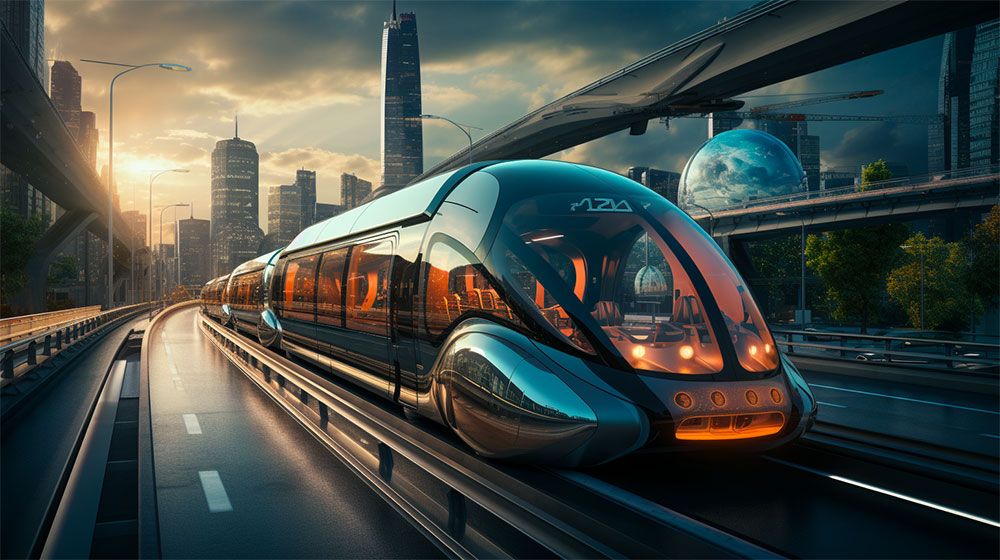Transportation and mobility are undergoing significant changes, propelled by technological advancements, environmental concerns, and evolving consumer preferences. As cities expand and populations grow, the demand for efficient, sustainable, and cost-effective transportation solutions has never been greater. With the rise of electric vehicles, autonomous technology, and shared mobility services, the landscape of how we move from place to place is rapidly transforming. In this article, we explore the current trends shaping transportation, the innovations that are redefining mobility, and the challenges that lie ahead as we move towards a more interconnected, sustainable future.
The Evolution of Transportation and Mobility
Transportation has evolved from simple, manually-powered vehicles to sophisticated systems capable of carrying people and goods across the globe. For centuries, the horse-drawn carriage was the primary mode of transportation, offering mobility that was largely limited to regional travel. The industrial revolution ushered in the age of steam-powered locomotives, automobiles, and eventually airplanes, allowing people to travel long distances in shorter periods of time. The 20th century saw the advent of mass-produced cars, particularly with the Ford Model T, which revolutionized personal transportation.
As the world enters the 21st century, transportation and mobility are becoming increasingly integrated with technology. The development of electric vehicles (EVs), autonomous driving systems, and the concept of Mobility as a Service (MaaS) have drastically altered how we think about transportation. MaaS platforms allow individuals to access various transportation modes (buses, trains, shared rides, and bikes) from a single app, offering more flexibility and reducing the need for car ownership. The future of transportation will not only focus on moving people and goods but also on optimizing routes, improving sustainability, and increasing accessibility for all.
Current Trends Shaping Transportation and Mobility
Today, several trends are reshaping transportation and mobility, driven by the desire for efficiency, sustainability, and innovation. One of the most significant trends is the rapid rise of electric vehicles (EVs), which are playing a crucial role in reducing carbon emissions and improving air quality. As governments worldwide introduce stricter environmental regulations, more people are opting for EVs over traditional gasoline-powered cars. Companies like Tesla, Nissan, and Chevrolet are leading the way in producing affordable, high-performance electric cars, while global automakers are investing heavily in EV development to stay ahead of the curve.
Shared mobility is also gaining traction, particularly in urban areas where congestion and parking are significant concerns. Ride-sharing services like Uber and Lyft, along with bike and scooter-sharing programs, have made it easier for people to move around cities without the need for personal vehicles. This shift is helping to reduce traffic congestion, lower emissions, and provide more affordable transportation options.
Autonomous vehicle technology is another major trend revolutionizing the transportation sector. Self-driving cars have the potential to make transportation safer and more efficient by reducing human error, optimizing traffic flow, and allowing passengers to use their commute time more productively. While fully autonomous vehicles are still in the testing phase, companies like Waymo and Uber are making significant strides toward widespread adoption.
Micro-mobility, including electric scooters and bikes, is another emerging trend that addresses short-distance travel. These vehicles offer a convenient and eco-friendly alternative to traditional transportation in congested urban environments. With their ability to quickly maneuver through traffic and reduce reliance on larger vehicles, micro-mobility options are becoming increasingly popular in cities worldwide.
Innovations Transforming Transportation and Mobility
Innovation in transportation and mobility is moving at a rapid pace, with new technologies continuously reshaping the way we travel. One of the most exciting developments is smart infrastructure, which leverages technology to optimize traffic management, reduce congestion, and improve safety. By integrating sensors, cameras, and communication systems, cities can monitor real-time traffic conditions and adjust traffic signals to improve flow, minimize delays, and reduce accidents. Smart infrastructure can also help cities better manage public transportation systems, ensuring buses and trains run on time and efficiently serve commuters.
Electric aircraft are also gaining attention as a promising innovation in air travel. Companies like Joby Aviation and Lilium are developing vertical take-off and landing (VTOL) aircraft that could revolutionize short-distance air travel. These electric aircraft are quieter and more environmentally friendly than traditional airplanes, and they have the potential to significantly reduce travel times between cities. As air travel continues to become more accessible, these innovations could play a key role in reshaping the future of mobility.
The development of high-speed transport systems, such as the Hyperloop, promises to further accelerate the future of transportation. The Hyperloop, a proposed system of vacuum tubes that propel pods at speeds exceeding 700 miles per hour, could drastically reduce travel times between cities, making long-distance commutes more feasible. While this technology is still in the early stages, companies like Virgin Hyperloop are working to bring this concept to life, and its success could be a game-changer for both passengers and freight transport.
Autonomous public transportation is another area of innovation. Self-driving buses, trains, and shuttles could provide more efficient and cost-effective ways to move people in cities. These vehicles can reduce the need for human drivers, lower operating costs, and provide more frequent and flexible service. Additionally, autonomous public transport could be integrated with other smart mobility solutions, creating a seamless transportation experience for urban commuters.
Challenges Facing the Transportation and Mobility Sector
While the future of transportation and mobility holds immense promise, several challenges remain. One of the most pressing issues is the environmental impact of traditional transportation. Despite the rise of electric vehicles, many regions still rely on fossil-fuel-powered cars and trucks, contributing to air pollution and greenhouse gas emissions. To address this, governments are implementing stricter emissions regulations and encouraging the adoption of cleaner technologies. However, transitioning to more sustainable transportation options requires significant investments in infrastructure, technology, and consumer adoption.
Another challenge is the infrastructure gap. Many cities are not fully equipped to handle the demands of modern transportation systems, especially as new technologies like electric vehicles and autonomous cars become more prevalent. For example, the widespread adoption of EVs requires an extensive network of charging stations, which is currently lacking in many regions. Additionally, existing roads and public transport systems may need to be upgraded to accommodate new mobility solutions, such as self-driving vehicles and shared mobility services.
Data privacy and security are also critical concerns, especially as transportation systems become more interconnected. Autonomous vehicles, ride-sharing platforms, and smart infrastructure all rely on large amounts of data to function efficiently. However, this data must be protected from cyber threats to ensure the safety of users and prevent potential misuse. Striking the right balance between innovation and privacy will be essential for maintaining public trust in emerging mobility technologies.
Finally, regulatory hurdles pose a significant challenge to the adoption of new transportation solutions. Governments around the world are still working to develop appropriate laws and regulations for autonomous vehicles, electric aircraft, and other emerging technologies. Policymakers must address issues related to safety, liability, insurance, and infrastructure before these technologies can be deployed on a large scale.
How Transportation and Mobility Are Shaping the Economy
Transportation plays a crucial role in the global economy, influencing trade, commerce, and job creation. As transportation systems become more efficient and sustainable, businesses can access new markets, reduce supply chain costs, and improve delivery times. The growth of shared mobility services and electric vehicles has also created new opportunities for job creation, from the development of EV infrastructure to the expansion of ride-sharing companies.
The shift towards autonomous vehicles could have profound economic implications. While some fear that automation will lead to job losses in the transportation sector, others argue that it will create new opportunities in fields like vehicle maintenance, data analysis, and software development. Autonomous vehicles also have the potential to reduce the cost of transportation for consumers and businesses alike, ultimately benefiting the economy as a whole.
Moreover, the growth of electric vehicles and sustainable transportation solutions is expected to drive innovation in related industries, such as renewable energy, battery technology, and smart grid systems. As more cities invest in electric and shared mobility infrastructure, local economies will benefit from job creation and increased economic activity.
The Role of Smart Cities in Transportation and Mobility
Smart cities are increasingly becoming hubs for innovative transportation and mobility solutions. By incorporating technology and data analytics into urban planning, cities can optimize transportation networks, improve efficiency, and reduce congestion. For example, smart traffic management systems use real-time data to adjust traffic signals, reducing delays and improving safety. These systems can also monitor air quality and noise levels, helping cities become more sustainable.
The integration of electric vehicles, shared mobility services, and autonomous vehicles into smart cities will make transportation more efficient, affordable, and environmentally friendly. As these technologies evolve, urban areas will become more connected, offering seamless mobility experiences for residents and visitors alike. Public-private partnerships will play a key role in advancing smart mobility solutions, ensuring that cities are ready to meet the demands of a rapidly changing transportation landscape.
Looking Ahead: What’s Next for Transportation and Mobility?
The future of transportation and mobility is bright, with advancements in technology continuing to reshape how we move. We may soon see flying cars, drone deliveries, and hyperloop systems that make long-distance travel faster and more efficient. Autonomous vehicles will become more common, providing safer and more convenient options for getting around. And with a greater focus on sustainability, the transportation industry will continue to innovate to reduce its environmental impact.
As these changes unfold, the key to success will be collaboration between governments, businesses, and consumers. By working together, we can build a transportation system that is efficient, sustainable, and accessible to all.
FAQ
- What are the most significant trends in the future of transportation?
- Electric vehicles, autonomous technology, shared mobility services, and smart infrastructure are among the major trends reshaping transportation.
- How are smart cities influencing transportation and mobility?
- Smart cities leverage technology and data to optimize traffic flow, improve safety, and integrate sustainable transportation options, such as electric and shared mobility.
- What role do environmental concerns play in shaping future transportation solutions?
- The transportation sector is focusing on reducing carbon emissions through the adoption of electric vehicles and sustainable mobility options.
- How will autonomous vehicles affect the economy?
- Autonomous vehicles are expected to create new job opportunities while reducing transportation costs and improving safety.
- What are the challenges of implementing new mobility solutions in urban areas?
- Infrastructure limitations, regulatory issues, and data privacy concerns are major obstacles to the widespread adoption of new mobility solutions.











